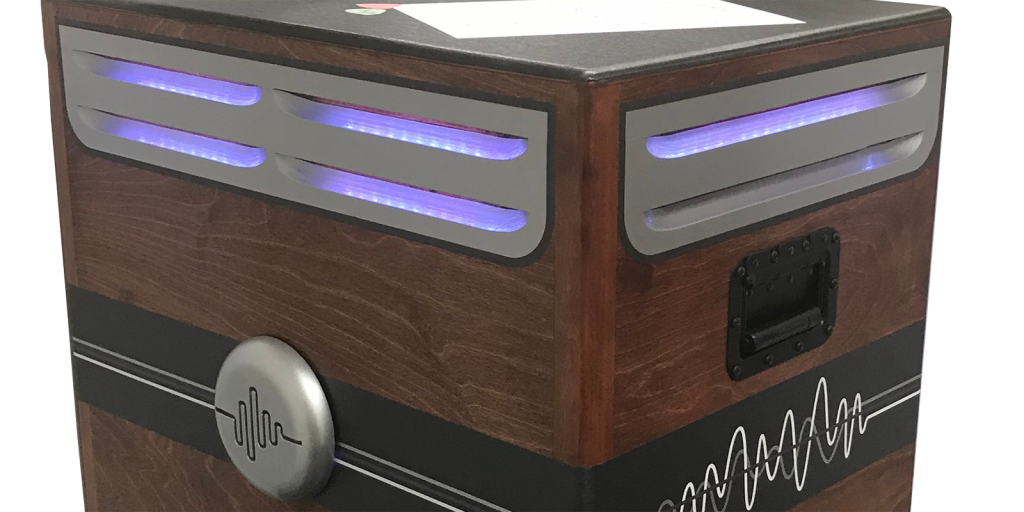John Lennon loved to distort his voice. For his recording of “Tomorrow Never Knows,” he asked for his voice to sound like “the Dalai Lama singing from the highest mountain top.” Engineer Geoff Emerick and the studio team put his voice through a Leslie speaker. According to Beatles biographer Bob Spitz, the effect enchanted John Lennon. He asked if hanging himself upside down and spinning while he sang would mimic the same effects.
The Leslie speaker was featured many times on Beatles recordings after that for vocals and instruments, although most famously on “Tomorrow Never Knows.” It remains one of the most well-known Leslie-aided records. However, the Beatles didn’t make the Leslie famous. This studio staple came to be 20 years prior and had been used by musicians since its inception to produce a legendary, exciting sound.
Donald Leslie invented the speaker after he bought an electric Hammond organ in the 1940s that disappointed him. He wanted the vibrating, warbling sound of a pipe organ. To solve his problem, he created a rotating speaker cabinet, eventually known as the Leslie, that emulated those sounds.
It used the Doppler effect and relied on two motored speakers on different levels. One was treble and rotated around a fixed pivot point high in the cabinet. The other was lower and bass, inside a rotating drum with a small sound escape point.
Initially creating it for Hammond organs, Donald Leslie tried to sell his design to Hammond organ company. However, the organ inventor Laurens Hammond rejected the speaker system. Hammond disliked it so much that he even designed his organs to be incompatible via connection.
Rather than give up, Leslie developed the speaker under his own brand and sold his Leslie speakers until he couldn’t keep up with the demand. Eventually, the Leslie line had multiple models, such as the 122 —commonly used with B3s —and the 147. They had different effects to varying degrees, but they all relied on the same mechanics and principles.
Church organists loved the Leslie. Studio rooms, churches, gospel choirs and traveling bands adopted these rotating speakers. Even at 150 pounds and difficult to transport, people wanted them. Big bands and larger groups traveled with them. No one could get enough of The Sound. Audio teams hooked these modification devices up to guitars, tambourines, organs and vocals. It became an essential equipment piece, used in many well-known records, such as Elton John’s “All the Girls Love Alice.”
Engineers and musicians loved not just the sound, but the design of the equipment. It was timeless and difficult to improve. BookerLAB CEO Tom O’Hanlan remembers seeing his firstLeslie 147 with a Combo Preamp, which belonged to the keyboardist in his high school band.
“I was enthralled by its complexity and simplicity. What the Leslie does to sound is amazing and how it does it is amazing. The design, the modularity, the upward compatibility and the ability to band-aid one in the field were legendary,” explains O’Hanlan. He got his own 122 Leslie in 1992, along with a Hammond C3.
Today, forums and groups across the country have a special place in their hearts for these nostalgicgems. People prefer vintage Leslies because they appreciate the speaker’s originality. There’s also a sense of paying homage to the innovators of music.
It’s less common to see Leslie speakers in use today, except in studios, churches or throwback bands.People refurbish them in DIY but finding new or unused parts can be difficult. Even after restoration and installation, maintenance can also be a problem for users and collectors. Nonetheless, musicians and artists want the real deal over digital mimics.
That passion is why we wanted to make the Revolution: The Advanced Motor Controller. A Leslie speaker should be used. Installing updated parts with advanced engineering will ensure the continued legacy of a Leslie. If you want to participate in the long history of Leslie speakers, reach out to us. We’ll help you rock on.









I have Two B3’s and 2 x A100’s and about seven Leslies. So I am always interested in making the Leslies more reliable.
Please send me info.
That’s an amazing collection; we’ll be in touch via email.
I own a 145 with the 147 amp. It’s been modified the side louvers were routed out, the speaker cavities & back are painted gloss white, it’s got a coupled Peavey Scorpion driver for the chorale. The motors require attention periodically & are and what unreliable when the Leslie is moved. It currently stays in the studio.
We’d love to see a picture; we’ve got a “hot rod” version in-house that has been wrapped and lined with LED lights. We’re working on a good replacement motor solution now!
THE LESLIE AND THE HAMMOND IS LIKE PEANUT BUTTER AND JELLY.
True words – and we’re working to make sure that peanut butter is as smooth as it can be!
I am currently using two modified 122 Leslie cabinets but without the original amplifiers and motor switching in the original. Currently have it set up that I can engage fast or slow motors but do not have the capability to stop them from spinning. I would like to hear more about your product for motor speed control.
Awesome – we’re working to make that as easy as we can. We’ll be in touch via email – thank you!
Using our Vintage Motor Controller, VMC, you can add Stop and Memphis Mode (lower only stop). We do this by controlling the voltage to the motors individually. You could “sync” two Leslies easily with this setup, using MIDI from your keyboard, or a footswitch/halfmoon switch. Hope this helps!
Thanks for this. I’ve listened to 2 Hammonds with a Leslie attached. One was in my church when I was growing up. The other was at the Ottawa Jassfest several years ago. Right now there’s a big Hammond organ offered free to anyone in my area (often as churches are closed for good). My first question was ‘does it have a Leslie with it?’
So many folks heard a Leslie for the first time in church – whether they realized it or not!
I am glad to be a part of this forum. Obviously the Leslie speaker is closely associated with Hammond organs. As is mentioned above, the Leslie can impart an ethereal wobble to any instrument, voice, etc that you put through it, with amazing results. The psycho-acoustic Doppler effect can be synthesized but not duplicated.
It’s like the difference between a live string section & a Mellotron, but in reverse. This is already getting complicated so I’ll just leave it there. I also love Mellotrons.
So I have 2 orphan Leslies (a 110 & a 615) & a 50’s Hammond M3. I place a Korg SV1 on the M3, mostly for the Wurly & Rhodes tones. I run that through a Roland KB amp.
I have yet to run the 615 because of connectivity issues. This model Leslie has four dedicated internal solid estate amps: which activate the rotating horn & driver; & a variety of side-mounted 6×9 speakers, with a 12” Woofer & a rotating bottom with a 6×9. I want to convert this to a slave 12” rotating woofer & rotating horn. Simplify! Any hints would be appreciated!
The M3 only has 1/4” pre-amp output jack, & I run it through a 1968 dripframe Fender Princeton Reverb which drives a vintage 12” Fender speaker. The 15 watt tube amp is warm & a nice volume for the studio. The previous Jensen failed during a loud jam session using a solid estate amp. I sometimes use a Danelectro Transparent Overdrive to boost the signal. I also have a Jekyll & Hyde OD/Distortion that I have yet to introduce to the rig.
Re: The above M3/Fender Princeton combo drives the Leslie 110 which only has the rotating 12” bottom. No horns.
Sounds like a beast! You obviously understand all this technical stuff! We can help ease the interface questions- check out the LBB family. Thanks
Well there are actually two versions of the Leslie sound: a recorded Leslie, and a live Leslie in a room. Unfortunately, most musicians today have only heard a recorded Leslie, and assume that’s the sound. The electronic imitations have become very good at reproducing this recorded sound and these musicians will say that they sound like the real thing. A live Leslie in a room is different (and awesome!) and cannot be imitated electronically because the sound literally comes from different directions as the rotors send it bouncing around. Hard to do with a stationary speaker… Our ears hear sound frequencies, amplitudes…and direction. It’s the sense of direction that’s missing from the electronic simulators. A stereo effect helps, but still isn’t the same. If you haven’t done so yet, go listen to an actual, live Leslie. Then decide what you want.
I’d love to have a Leslie 147 RV. I believe that’s what Eric Clapton and the Beatles used. Nothi
I own a Hammond B3 and Leslie 122. I just acquired a signed Hammond Clock Bank note certificate with Laurens Hammond’s autograph dated 1938. That was around the time Mr. Hammond changed the name to Hammond Organ.
If anyone knows where I can purchase any autograph related material of Donald Leslie I would greatly be indebted.
Hi am Jerry I own a Hammond c3 and have a m3 speaker I had my amp reworked. It gets out there. I have LEDs hook to motors drive and LEDs hook to power outputs on my Hammond so I can tell when I got power issues.. I done my own work.
That’s awesome, Jerry! Nothing like working on the old gear.
I’ve always wanted a Leslie to run my guitars/bass thru. Years ago i actually acquired an old organ with intent of harvesting the Leslie setup but time, knowledge and space were short and I ended up donating the organ to a local church.
However, I’d sure love to get into a stand- alone Leslie if one ever became Available. Or more likely if I were able to find original- revamped schenstics/ plans to build my own I’d sure be interested!
Schematics that is
I recently acquired a Leslie Model 122R from a retirement community, it hasn’t been used in quite a while and the organ that it was used with wasn’t available to check if it worked. It may or may not work but to find out.. I need any and all power cords and foot pedals or switches. I would like to use this with my guitar if that is possible. Any additional info is appreciated.
May 28,2023
There is a Leslie HP40 listed on eBay starting at $10.00 seller says if it doesn’t sell in one week it goes to the dump. Also no shipping local pickup only located in La Plata Maryland.
If any significance you better hurry.